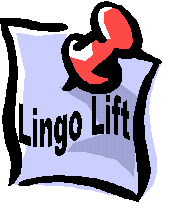
 Elaboration
Elaboration
Commonly
used terminology in our culture is hardly bias-free. We think in these
culturally-provided terms, though. And we think in culturally
conditioned ways.
People can fall into traps of stereotyping and overgeneralization and bias
without even being aware. Teachers are no exception. We teachers are
human. Our intentions may be exemplary, but we are often unaware of
elements of our own ethnocentrism. We may fail to make necessary and
careful distinctions (for example, between the teachings of any religion and the
behavior of the people who are adherents). We are as prone as anyone to
oversimplify, to emphasize one or two characteristics while sacrificing depth,
or to generalize from a limited domain to situations unsubstantiated by data.
For someone who strives for the neutral stance, language
is perhaps the most problematic of all areas to be faced. Sociologist
Ayad Al-Qazzaz has a saying for teachers in his workshops on Islam:
"We can't think without a language, yet because of the language, we can't
think straight." In his presentations, he offers many examples of how
we can get caught in our English language and reach erroneous conclusions.
You can of course try to make purposeful changes for the better when
your goal is
neutrality. (Caution: Changing language changes thinking!).
Use Precise Terms
It is desirable that a teacher leave behind
"lay talk" and employ practiced vocabulary. You want to be as
academically precise as you can. In an academic sense, it would be preferable to use (and accustom your
students to using) whatever term is most exact in a circumstance.
Regarding the topic of religious neutrality, consider these words so often used interchangeably: "religion" / "faith"
/ "outlook" /
"life stance" / "heritage" / "tradition" /
"worldview". Were you to delve very deeply into studies of
religion and society, each of these would take on its particular meanings and
applicable contexts. Upon discovering the slightly
different connotations, ideally you would want to use the most fitting term.
You would apply those terms that most specifically
fit the narrow need in each instance.
The reality of common usage makes it difficult if not impossible to surmount
all the problems. It is hard to stop
using some terminology, however problematic it might be. Also, so many terms
have multiple meanings, which adds confusion. For example, in a
prior lesson of this series [Lesson 2, Step 2] you learned that one word—faith—is
a bit sticky.
One can hardly be expected to fine-tune terminology that
lies outside one's field. As classroom teachers, most of us must go with
customary terms of expression until we learn otherwise. In general,
though, as you become more
informed over time, you can purposefully refine your terminology, adopting usage
that is most precise and least confounding.
Counter Partiality
You
need to be alert to societal biases that afflict the nation at large
and try not to inadvertently transmit them. You will want to use impartial terminology wherever you
can, avoiding partial terms. Interestingly, in some
areas our language makes difficult even the best of intentions. Upon
consideration, seemingly
neutral terminology turns out to be not to be so nonaligned.
Many present problems when viewed from your key neutrality goal: to put the various "citizens" of your classroom onto a level playing
field as regards religion.
As was mentioned in Lesson 3, "religion" is not as inclusive a term
as is "worldview." The latter term is more attuned to all individuals.
(Everyone has a worldview; not everyone has a religion.) When you broaden
the
narrower concept of "religious diversity" "to speak of
"worldview diversity," no one is left out.
Elevating the criterion—civic equity, a level playing field for all—can
lead you over time to identifying several critical "terminology
shifts" you may wish to make.
Idea 2 "E Pluribus Unum"
